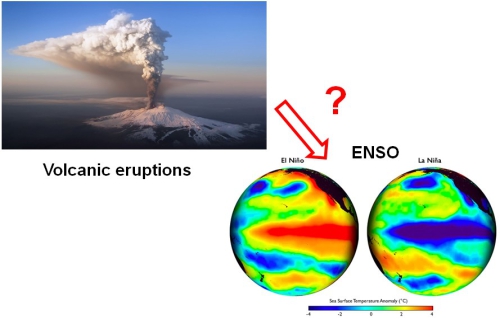
Volcanic eruptions are one of the most important natural causes of climate change, playing a leading role over the past millennium. Injections of sulfate aerosols into the lower stratosphere will reduce the incoming solar radiation, which in turn cooling the surface.
In recent years, scientists found that there is a relationship between volcanic eruptions and El Niño-Southern Oscillation (ENSO) based on reconstructions and model simulations, which is manifested in increased/decreased sea surface temperature (SST) gradient over the equatorial Pacific.
Since ENSO influences the global climate through atmospheric teleconnections, it is of great importance to understand the influence of volcanic eruptions on ENSO phase changes.
Recently, ZUO Meng, a doctoral student from the Institute of Atmospheric Physics (IAP) of the Chinese Academy of Sciences, along with her mentors Prof. ZHOU Tianjun and associate Prof. MAN Wenmin, used the CESM Last Millennium Ensemble (LME) simulations to investigate the different impacts of northern, tropical and southern volcanic eruptions on the tropical Pacific SST.
Analysis of the simulations indicated that the Pacific featured a significant El Niño-like warm SST anomaly 5-10 months after northern and tropical eruptions, with the Nino3 index peaks at the winter of next year. Compared with northern eruptions, the warm SST anomaly was mainly confined to the eastern Pacific with a stronger intensity following tropical eruptions.
Following southern eruptions, the Pacific showed a weaker warming anomaly over the eastern Pacific and the time at which the Nino3 index reached its peak was about 4 months earlier than that after northern and tropical eruptions.
They further put forward the underlying mechanism: The shift of the intertropical convergence zone (ITCZ) could explain the El Niño-like response to northern eruptions, which was not applicable for tropical or southern eruptions. Instead, the westerly anomaly in the western Pacific triggered by the ocean dynamical thermostat mechanism could explain the divergent SST responses following three types of eruptions.
"In contrast to previous works on the impacts of volcanic eruptions on SST, our results are based on the CESM-LME simulation. From a modeling perspective, ensemble simulations are the most helpful method to study volcano-forced responses. Most importantly, the different mechanisms of SST response to three types of eruptions can help us better understand the divergent formation processes of SST anomalies," said ZUO Meng, the first author of the paper.
"We hope the results are useful for the mitigation and adaptation of climate change after volcanic eruptions and the associated socioeconomic impacts, and can also provide insight for understanding future SST changes induced by large volcanic eruptions."

Relationship between volcanic eruptions and El Niño-Southern Oscillation (ENSO) phase. El Niño (La Niña) is the warm (cold) phase of ENSO, with a warm (cold) SST anomaly over the eastern equatorial Pacific. (Image from Google)
"Differences are also seen among different models. The difference may result from the uncertainties in the reconstruction of external forcing volcanic aerosol data, model bias, and also the initial condition of volcanic eruptions," said Prof. MAN Wenmin.
The study entitled "Different Impacts of Northern, Tropical, and Southern Volcanic Eruptions on the Tropical Pacific SST in the Last Millennium" was published in Journal of Climate.

86-10-68597521 (day)
86-10-68597289 (night)

86-10-68511095 (day)
86-10-68512458 (night)

cas_en@cas.cn

52 Sanlihe Rd., Xicheng District,
Beijing, China (100864)

